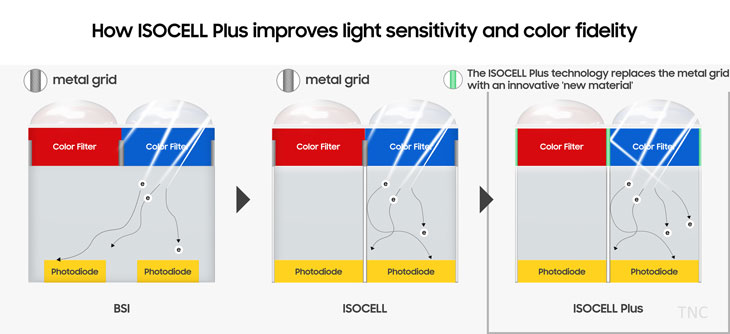
Korean Giant Samsung and imaging industry leader Fuji silently working together behind the curtain to create a completely new and more powerful ISOCELL sensor. The new ISOCELL PLUS sensor
.

Let me explain you what Fuji did inside ISOCELL sensor to make it ISOCELL PLUS, earlier every two-sub pixels of of ISOCELL sensor was separated by a metal grid. Now, the metal grid is replaced by Fuji new innovative material. (well they didn’t disclosed what the innovative material is).
Highlights of ISOCELL PLUS Sensors Press Release
- Today introduced its new ‘ISOCELL Plus’ technology
- Absorb and hold more light than the conventional backside-illuminated (BSI) image sensor
- Samsung replaced the metal barrier with an innovative new material developed by Fujifilm, minimizing optical loss and light reflection.
- The new ISOCELL Plus delivers higher color fidelity along with up to a 15-percent enhancement in light sensitivity
- The technology also enables image sensors to equip 0.8-micrometer (µm) and smaller-sized pixels without any loss in performance, making it an optimal solution for developing super-resolution cameras with over 20 megapixels
- The ISOCELL Plus will be showcased at the Mobile World Congress Shanghai, held from June 27 to 29.
With the help of new technology Samsung is not only able to create more better sensor, but they can also create higher resolution sensor without any loss in performance.
We also expect in near future both companies will work together for the betterment of Sensors as well imagine technology to bring new innovative products for for consumers.
Press Release ISOCELL PLUS Sensors
Samsung Brings Enhanced Color Accuracy and Sharpness to Mobile Photos with New ISOCELL Plus Technology
Korea on June 27, 2018
Optimized pixel isolation technology enhances light sensitivity and color fidelity
To take high-quality photographs, CMOS image sensors need to hold as much light, or photons, as possible and transmit the right color information to the photodiode. Such requirements were resolved by the introduction of Samsung’s ISOCELL technology in 2013. ISOCELL forms a physical barrier between the neighboring pixels, reducing color crosstalk and expanding the full-well capacity. This enables each pixel to absorb and hold more light than the conventional backside-illuminated (BSI) image sensor design for superior image quality.
With the introduction of ISOCELL Plus, Samsung pushes pixel isolation technology to a new level through an optimized pixel architecture. In the existing pixel structure, metal grids are formed over the photodiodes to reduce interference between the pixels, which can also lead to some optical loss as metals tend to reflect and/or absorb the incoming light. For ISOCELL Plus, Samsung replaced the metal barrier with an innovative new material developed by Fujifilm, minimizing optical loss and light reflection.
“We value our strategic relationship with Samsung and would like to congratulate on the completion of the ISOCELL Plus development,” said Naoto Yanagihara, corporate vice president of Fujifilm. “This development is a remarkable milestone for us as it marks the first commercialization of our new material. Through continuous cooperation with Samsung, we anticipate to bring more meaningful innovation to mobile cameras.”
The new ISOCELL Plus delivers higher color fidelity along with up to a 15-percent enhancement in light sensitivity. The technology also enables image sensors to equip 0.8-micrometer (µm) and smaller-sized pixels without any loss in performance, making it an optimal solution for developing super-resolution cameras with over 20 megapixels.
“Through close collaboration with Fujifilm, an industry leader in imaging and information technology, we have pushed the boundaries of CMOS image sensor technology even further,” said Ben K. Hur, vice president of System LSI marketing at Samsung Electronics. “The ISOCELL Plus will not only enable the development of ultra-high-resolution sensors with incredibly small pixel dimensions, but also bring performance advancements for sensors with larger pixel designs.”
The ISOCELL Plus will be showcased at the Mobile World Congress Shanghai, held from June 27 to 29.







Samsung go FF, Fuji APS-C and MF.
I can’t hardly wait to see this sensor in Fuji camera.
Unlike an organic sensor, it looks like, it’s going to happen.
If 15 stops DR on smartphone, then how many DR stops is going to be on bigger sensors?
I really do not care about more MP, I prefer less. Too sharp & detailed image makes me feel sick. This is why I do not buy any new camera & lens, anymore.
I’m only interested in more DR range, and color accuracy.